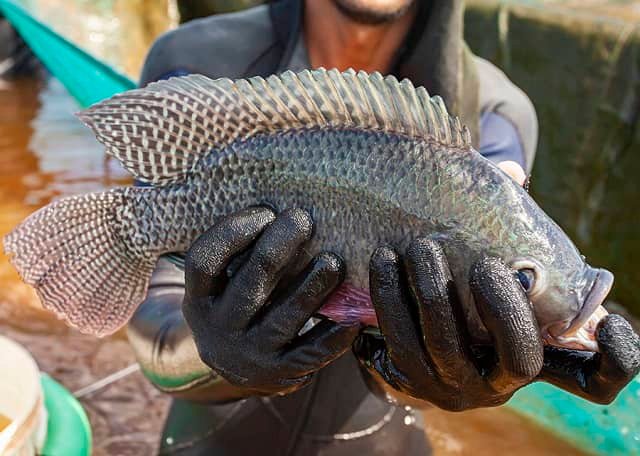
Nile tilapia is a species highly valued by fish farmers due to its resilience and established aquaculture techniques. But there’s always room for improvement, especially when it comes to raising healthy and prosperous young fish.
Conventional aquaculture often relies on inorganic fertilizers to cultivate plankton, a natural food source for fish. While effective, this approach can affect water quality.
In this regard, researchers from the Federal Rural University of Pernambuco evaluated the production of Oreochromis niloticus juveniles using different cultivation technologies: autotrophic, symbiotic, and bioflocs, through water quality parameters, plankton groups, bacterial counts, and zootechnical performance.
Exploring new frontiers in aquaculture
Traditionally, aquaculture has relied on well-defined methods for raising fish. This study takes a bold step forward by investigating the effectiveness of three emerging cultural technologies:
- Autotrophic (AUT): This system uses inorganic fertilizers (potassium nitrate and superphosphate) to stimulate the growth of natural food sources for fish.
- Symbiotic (SYNB): Symbiotic technology combines probiotics (beneficial bacteria) with prebiotics (food sources for these bacteria). Symbiotics create a thriving gut microbiome in fish, potentially improving their health and disease resistance.
- Bioflocs (BFT): Biofloc systems harness organic carbon sources to cultivate a dense microbial community within the water. These “flocs” not only clean the water by consuming waste products but also serve as a valuable food source for fish.
The experiment
The experiment lasted 40 days, mimicking the typical timeframe for Nile tilapia juveniles to reach commercial weight. Researchers monitored various factors to assess the effectiveness of each technology:
- Water quality: All treatments maintained water quality parameters such as temperature, oxygen levels, and pH within the recommended range for Nile tilapia.
- Nutrient management: Interestingly, BFT and SYNB systems showed a significant reduction in nitrogen compounds (ammonia and nitrite) compared to autotrophic and traditional control groups. This translates to a smaller environmental footprint and potentially less water needed for maintenance.
- Microbial communities: The experiment revealed distinct bacterial communities in each treatment. The BFT system had the highest overall bacterial count, while the SYNB system harbored a greater abundance of beneficial Bacillus bacteria.
- Plankton increase: Plankton plays a vital role in fish nutrition. BFT and SYNB systems fostered a thriving community of phytoplankton, particularly diatoms, which are a preferred food source for tilapia juveniles.
- Fish performance: Here’s the exciting part! Fish raised in BFT and SYNB systems showed superior growth and overall health compared to control and autotrophic groups. They achieved higher final weight, better feed conversion ratios, and exhibited better body condition.
The potential of new technologies
The results of this study are promising. Symbiotic and biofloc cultivation technologies offer a compelling alternative for raising healthy and productive Nile tilapia juveniles. This research has the potential to unlock new possibilities for:
- Improved tilapia growth and health: Understanding how these technologies influence growth performance and overall fish health is crucial for optimizing production.
- A thriving microbiome: Maintaining a healthy balance of microorganisms in the water can benefit both water quality and potentially improve fish gut health.
- Sustainable water usage: Minimizing water consumption per kilogram of fish produced is essential for environmentally responsible aquaculture practices.
Conclusion
“With this work, it can be observed that water quality, water footprint, temporal behavior of plankton, bacteriological parameters, and zootechnical performance of Nile tilapia juveniles within production are influenced by cultivation technologies, with an emphasis on biofloc and symbiotic, which showed the best results,” conclude the researchers.
This study convincingly demonstrates the potential of biofloc (BFT) and symbiotic (SYNB) technologies for superior Nile tilapia juvenile production. These systems offer a winning combination of:
- Better water quality management.
- Thriving plankton communities.
- Abundant beneficial microbes.
- Exceptional fish growth and health.
As aquaculture continues to evolve, the adoption of innovative technologies like bioflocs and symbiotics can pave the way for a more sustainable and productive future. By fostering healthy ecosystems for both fish and beneficial microbes, these approaches can help us raise healthy fish while minimizing environmental impact.
Contact
Juliana Ferreira dos Santos
Departamento de Pesca e Aquicultura, Universidade Federal Rural de Pernambuco
Dois Irmãos, Recife, Pernambuco 52171-900, Brazil.
Email: juliana.fsantos@ufrpe.br
Reference
Nunes, L. J. L., Da Silva Campos, C. V. F., Da Silva, S. M. B. C., Gálvez, A. O., Brito, L. O., & Dos Santos, J. F. (2024). The culture of Nile tilapia (Oreochromis niloticus) juvenile at different culture technologies: Autotrophic, bioflocs and synbiotic. Aquaculture, 588, 740912. https://doi.org/10.1016/j.aquaculture.2024.740912
Editor at the digital magazine AquaHoy. He holds a degree in Aquaculture Biology from the National University of Santa (UNS) and a Master’s degree in Science and Innovation Management from the Polytechnic University of Valencia, with postgraduate diplomas in Business Innovation and Innovation Management. He possesses extensive experience in the aquaculture and fisheries sector, having led the Fisheries Innovation Unit of the National Program for Innovation in Fisheries and Aquaculture (PNIPA). He has served as a senior consultant in technology watch, an innovation project formulator and advisor, and a lecturer at UNS. He is a member of the Peruvian College of Biologists and was recognized by the World Aquaculture Society (WAS) in 2016 for his contribution to aquaculture.
